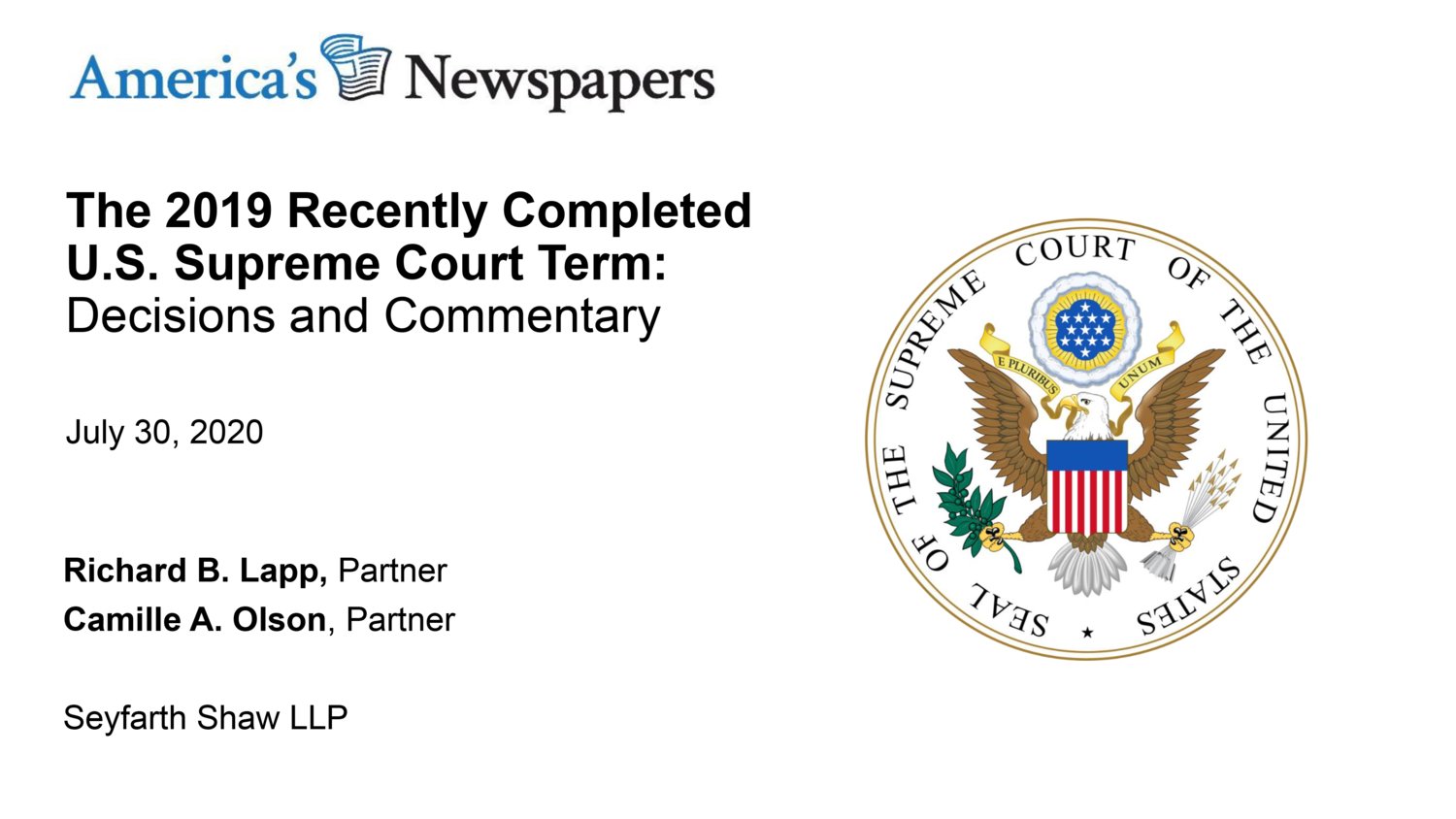
Presented by Camille Olson, partner, and Richard Lapp, partner, Seyfarth Shaw LLP
COVID comes to court. The virus made this an unusual Supreme Court term. The court’s final opinions stretched into July, the first time in two decades. Hearings and arguments were made remotely. For the first time ever, the court provided live audio of oral arguments.
Garbo, er, Thomas speaks! Justices used an ordering process whereby the justices asked questions individually, according to a time limit and in order of seniority. As a result, Justice Clarence Thomas, usually a silent participant in oral argument, participated fully in questioning the litigants during his turn.
No buts about it. In Comcast Corp. v. National Assoc. of African American Owned Media, the court ruled unanimously that plaintiffs must show that “but for” race discrimination, an employer’s action wouldn’t have happened. This was a victory for employers by streamlining and clarifying race discrimination.
Seyfarth Shaw’s comment: “We note that the practical impact of the case is that the court has posed one of the strictest tests for discrimination cases — it is also the test used to evaluate allegations of racial bias in employment under Section 1981 (of Title VII of the Civil Rights Act of 1964).”
A decision for the ages. Babb v. Wilkie looked at age discrimination in federal employment. In this decision, plaintiffs needn’t meet that “but for” standard, but if the plaintiff is looking for a money award, new job or other compensation then must show that the employers action was “but for” age.
Let’s talk about sex. In a 6-3 decision in Bostock v. Clayton County, Georgia, the court ruled that employment discrimination based on sex includes homosexuals or transgendered people under Title Seven of the 1964 Civil Rights Act.
A Hail Mary argument. In Our Lady of Guadalupe School v. Morrissey-Berru, two teachers claimed discrimination when they were fired at a Catholic school because they were acting in ways that did not comport with the faith. Broadly, religious institutions have a “ministerial exception” from discrimination laws. Here the court said the teachers were responsible for, among other duties, teaching the Catholic faith to their students.
I hear things… What responsibilities do so-called insider-fiduciaries — typically company executives who also manage retirement plans — have to disclose possibly pertinent information they come across in their executive role? In Retirement Plans Comm of IBM v. Jander, the issue concerned insider-fiduciaries who didn’t disclose that IBM’s microelectronics business was, well, bleeding money. The Second Circuit federal court had ruled IBM’s inside-fiduciaries violated ERISA by failing to disclose. The betting was that the Supreme Court would reverse that finding — ending so-called ERISA stock-drop cases. Instead, the court remanded the case to the Second Circuit.
ERISA, etc. In another case concerning retirement statutes, Intel Corp. Investment Policy Committee v. Sulyma, a participant essentially wanted a longer time to make legal complaint against a pension plan. The statute of limitation generally is six years to make a legal claim against a fiduciary of a pension plan. If, however, a participant has “actual notice” of, say, a risky investment, the statute of limitation is three years. The court said “actual notice” must mean when the plan participant realizes something is amiss, not when he is flooded with legalese information about the retirement plan. But in practical terms, fiduciaries can show the notices they gave — and argue the plaintiff was “willfully blind” to that information.
ERISA, etc., etc. The issue in Thole v. US Bank was whether the bank’s retirees had standing to bring a defined benefit pension mismanagement lawsuit over a plan that guaranteed a fixed monthly payment regardless of the plan’s value or the fiduciaries’ investment decisions. The 5-4 decision said they didn’t — and may eliminate ERISA fiduciary breach suits against fully funded defined pension plans if the retirees neither lost money nor face a substantial risk of losing money. That’s whether or not the retirees could prove “egregious plan mismanagement.” Sharp lawyers detected some language in the decision as potentially limiting lawsuits against 401(k) plans as well.
Contra contraceptives. Under the Affordable Care Act, some businesses and institutions, chiefly religion-affiliated health care providers, can be exempted from having to offer birth control in their health plans. During the Trump administration, that was extended to other non-profits. The court in Little Sisters of the Poor Saints Peter and Paul Home v. Pennsylvania said the same “sweeping authority” government got under the act to mandate contraceptive coverage gave it the ability to extend exemptions.
Clearing the docket. Quick takes on some other notable Supreme Court rulings this term:
All persons having business before this court… Want to follow up with the Seyfarth Shaw presenters? Contact Camille Olson at colson@seyfarth.com or (312) 460-5831, and Richard Lapp at rlapp@seyfarth.com or (312) 460-5914.